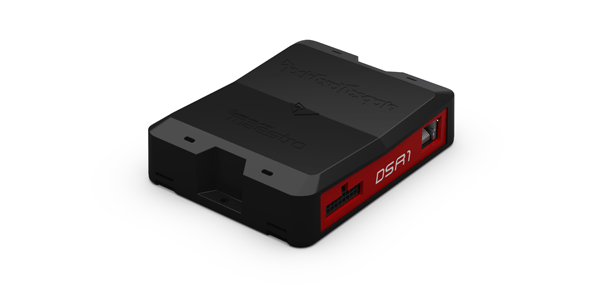Rockford Fosgate is introducing a new car digital signal processor (DSP) that combines a Rockford 3Sixty DSP with an ADS iDatalink Maestro interface.
The new DSR-1 was co-developed by Rockford and ADS as a full featured 3Sixty plus a flashable Maestro that can link to the CAN bus of a car. You can now add amplifiers to the car’s system BEFORE the factory amplifier to avoid all the factory DSP, it said.
“The DSR-1 is the first real solution for replacing the factory amplifier and speakers in Ford and Chrysler vehicles,” said Rockford VP Product Development & Engineering Jake Braaten. “The DSR-1 uses the full-range, flat audio signal from the factory head unit. After the built-in Maestro interface is flashed with the vehicle-specific firmware, the factory head unit CAN messages are used to control the internal signal routing of the DSR-1. Prior to the DSR-1, installers had no choice but to add amplifiers after the factory amplifier which required complex signal summing as well as de-equalization and time alignment.”
The DSR-1 can work with an audio tuning app for iOS and Android devices.
The DSR-1 includes 4-channel balanced differential RCA inputs, 4-channel high level inputs with signal sense turn on, 8-channels of 4-volt capable RCA outputs, remote Turn On/Off Function with adjustable Turn On delay, and auxiliary RCA and SPDIF coaxial inputs.
When used in late model Ford and Chrysler vehicles, the DSR-1 can be installed with one of three plug-and-play harnesses available at launch. After installation, the factory tone controls and sound field settings are remapped to control like adjustments within the DSR-1. For example, the use of the factory bass control is used as the sub-volume adjustment of the DSR-1 eliminating the need to install extra controllers or knobs.
The DSR-1 has a low suggested retail price of $249.99. It will join other 3Sixty processors that remain in the line. It will be on view at the SEMA Show in Las Vegas November 1-4, booth N11839, Las Vegas Convention Center.
Additional DSR-1 specifications and features include:
• Frequency response: 20 – 20k +/- 0.5 dB
• 239 Bands of Equalization for Aftermarket Tuning
• Adjustable crossovers with selectable slope and crossover type
• Crossover Frequency: 20 – 20k Hz
• Time Alignment of up to 10msec of delay on each channel
• Bluetooth 4.0 Connectivity for convenient setup
• Interactive Tuning Interface Controlled via Android/ iOS APP
• Optional PLC2 Level Controller with Assignable Functions
• Dimensions (L x W x H): 5.12 in. x 4.04 in. x 1,26 in.)
• CE Compliant
Vehicles covered with integration at launch
• 2011 to current Ford and Lincoln vehicles with 8-inch My Ford Touch radio and Sony amplifier
• 2012 to current Chrysler, Dodge, Jeep and Ram vehicles with 8-inch radio and factory amplifier









I don’t want to assume the answer, so I’ll ask. What about those factory systems that CHANGE the applied EQ as the volume knob is adjusted?
This is HUGE. It will absolutely change the way we approach integration and choosing what DSPs we sell and install!
Where the hell is the CENTER channel (and to an extent, SURROUND) support? These vehicles ship with center channels and a proper DSP can make use of them.
At the present, I’m running a 2015 Durango through the aging but capable JBL MS-8, tapped from the outputs of the stock amp. It works extremely well but the only way I’m replacing it or installing for others when there’s a center channel in the system, is if the DSP supports it. If the car has it, the DSP should support it.
They talked about this a kfest….
WOW. Unless I’m misreading something here this has the potential to reshape the DSP market completely, especially as more harnesses and vehicle software options become available.
Is it shipping?